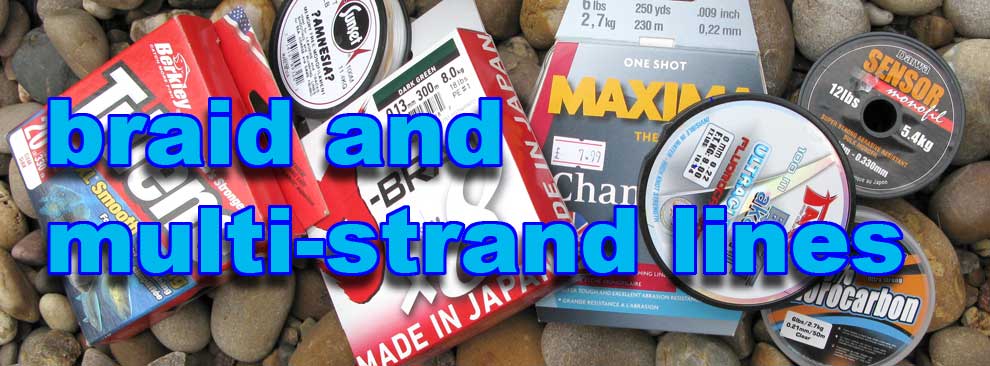line strength
Fishing line is measured by either its diameter, being thick or thin, or by its breaking strain (B.S.), being heavy or light. Although the line diameter remains almost constant, its breaking strain is variable as it is dependent upon the knots used.
With this in mind, most angling knots are rated by percentage, meaning if a knot is rated at 90%, the line strength is reduced by 10%.
For spinning it is better to use as light a line as is sensible, allowing the lure to be cast as far as possible without impeding the action of the during the retrieve.
monofilament line
The least expensive and most common fishing line is Monofilament 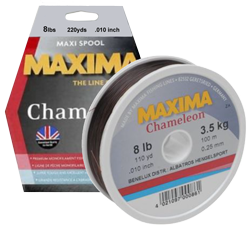 line, which can be hard (stiff) or soft (limp)—hard mono has a smaller diameter and less stretch than a comparable soft mono. Hard mono is also said to have more memory than soft mono, making hard mono more liable to twist; applying more to multiplying reels than fixed spool spinning reels. Although angling journals regard mono as 'old school', offering little to lure anglers, 5·5 kg (12 lb)=0.32 mm hard mono line is still hugely popular, particularly with those new to spinning.
line, which can be hard (stiff) or soft (limp)—hard mono has a smaller diameter and less stretch than a comparable soft mono. Hard mono is also said to have more memory than soft mono, making hard mono more liable to twist; applying more to multiplying reels than fixed spool spinning reels. Although angling journals regard mono as 'old school', offering little to lure anglers, 5·5 kg (12 lb)=0.32 mm hard mono line is still hugely popular, particularly with those new to spinning.
5·4kg (10lb) mono is considered light, whilst 6·8kg (15lb) mono is considered to be heavy.
fluorocarbon line
Other than being invisible underwater, Fluorocarbon line has much the same properties as mono line and is becoming ever more popular as a main line.
In the UK lure fishing fraternity it is mostly used as a rubbing trace or leader when using P.E. braided line. In the U.S. professional lure fishing circuit it is mostly used as main line, which is slowly but surely being adopted by British anglers.
Again, when used as a main line, 5·4kg (10lb) fluorocarbon is considered light, whilst 6·8kg (15lb) is considered to be heavy.
P.E. braided line
Polyethylene braided filament line has virtually no stretch, allowing the 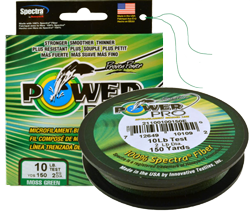 angler to feel every knock and pull on the lure. Being thinner and more limp than mono, it increases casting distance and allows more control over the lure during the retrieve. Although more expensive than mono, it is far less robust and some brands of 4 strand P.E. braid line can also be quite abrasive. The smoother, less abrasive 8 strand P.E. braid line further improves casting distance but is just as delecate as 4 strand.
angler to feel every knock and pull on the lure. Being thinner and more limp than mono, it increases casting distance and allows more control over the lure during the retrieve. Although more expensive than mono, it is far less robust and some brands of 4 strand P.E. braid line can also be quite abrasive. The smoother, less abrasive 8 strand P.E. braid line further improves casting distance but is just as delecate as 4 strand.
Care must be taken to use conventional P.E. braid knots for attaching 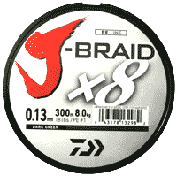 swivels and clips. Also, because P.E. braid line has a tendency to slip around the reel spool under pressure, a couple of turns of electrical insulating tape around the spool before loading will correct it. Check out You Tube 'loading braid fishing line'.
swivels and clips. Also, because P.E. braid line has a tendency to slip around the reel spool under pressure, a couple of turns of electrical insulating tape around the spool before loading will correct it. Check out You Tube 'loading braid fishing line'.
To compensate for its much finer diameter, most lure anglers up the weight of braided line on their spools to 8·1 kg.(18 lb.)=0·13mm or even up to 9·1 kg.(20 lb)=0·16mm., which makes it easier to knot.
other multiple strand lines
Although being the latest least expensive multiple strand line and having the huge Zebco brand behind it, Quantum Exo line has not been a 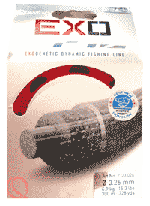 big hit in the U.K. Although looking and feeling much the same as fluorocarbon line, it has less stretch and a smaller comparable diameter 6·9 kg (15·3 lb)=0.26mm., making it suitable for general spinning.
big hit in the U.K. Although looking and feeling much the same as fluorocarbon line, it has less stretch and a smaller comparable diameter 6·9 kg (15·3 lb)=0.26mm., making it suitable for general spinning.
Being far less expensive than P.E. braid and other brands of multiple strand lines, it seems a natural step-up for mono line enthusiasts. The full name on the pack is Exogenetic Dynamic Fishing Line. Because it has a "Nano Fluorocarbon Coating" giving it a "Ultra Smooth Surface", it is best tied using conventional P.E. knots.
More expensive and promoted by Berkley, 'NanoFil' also has a multiple strand core within a 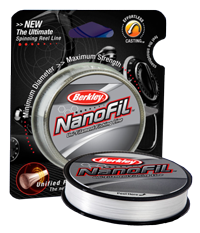 smooth outer coating. Compared to similar strength mono and P.E. braid, this line is much more limp with little or no stretch. Generally costing less than 4 strand P.E. line, it is far less abrasive than most 4 strand P.E. lines 7·7 kg (17 lb)=0·25mm. Again it is recommended that it is best tied using conventional P.E. knots.
smooth outer coating. Compared to similar strength mono and P.E. braid, this line is much more limp with little or no stretch. Generally costing less than 4 strand P.E. line, it is far less abrasive than most 4 strand P.E. lines 7·7 kg (17 lb)=0·25mm. Again it is recommended that it is best tied using conventional P.E. knots.
